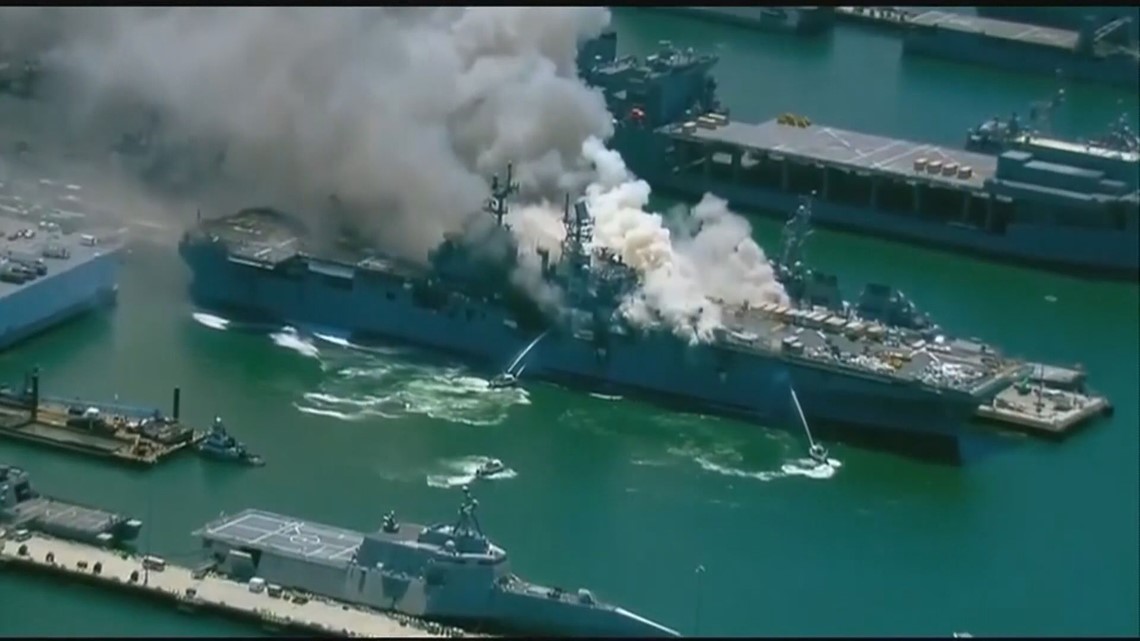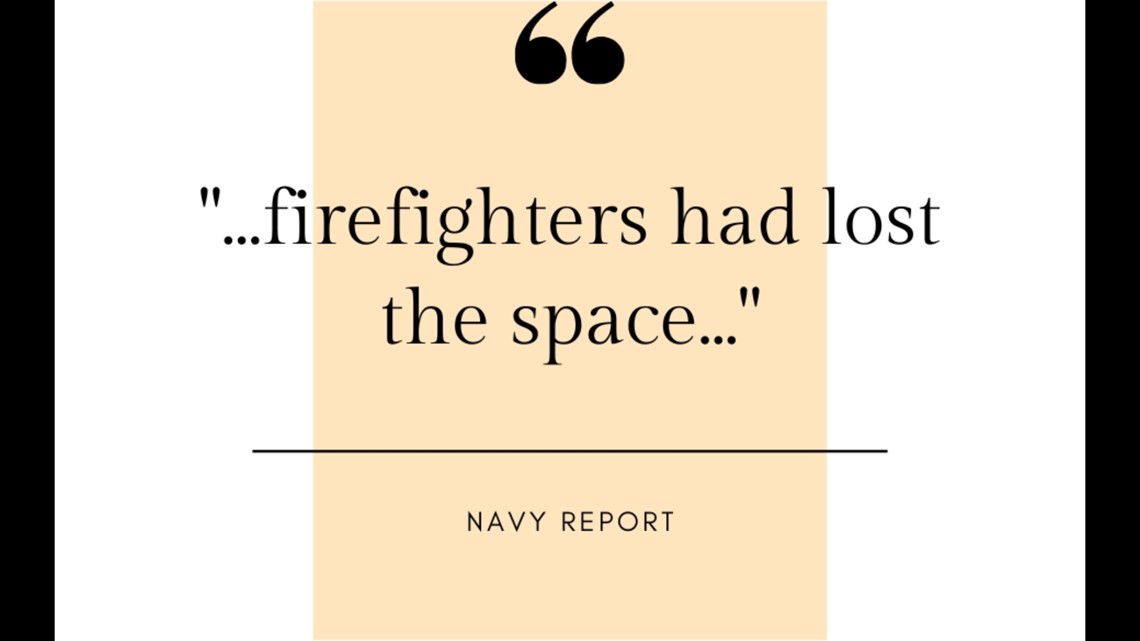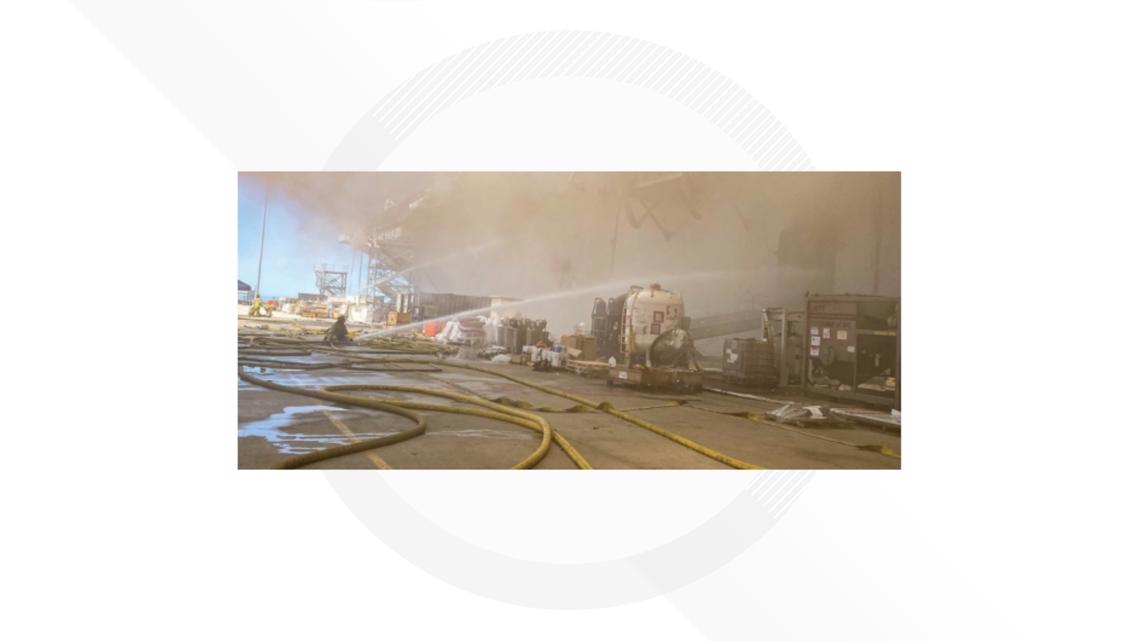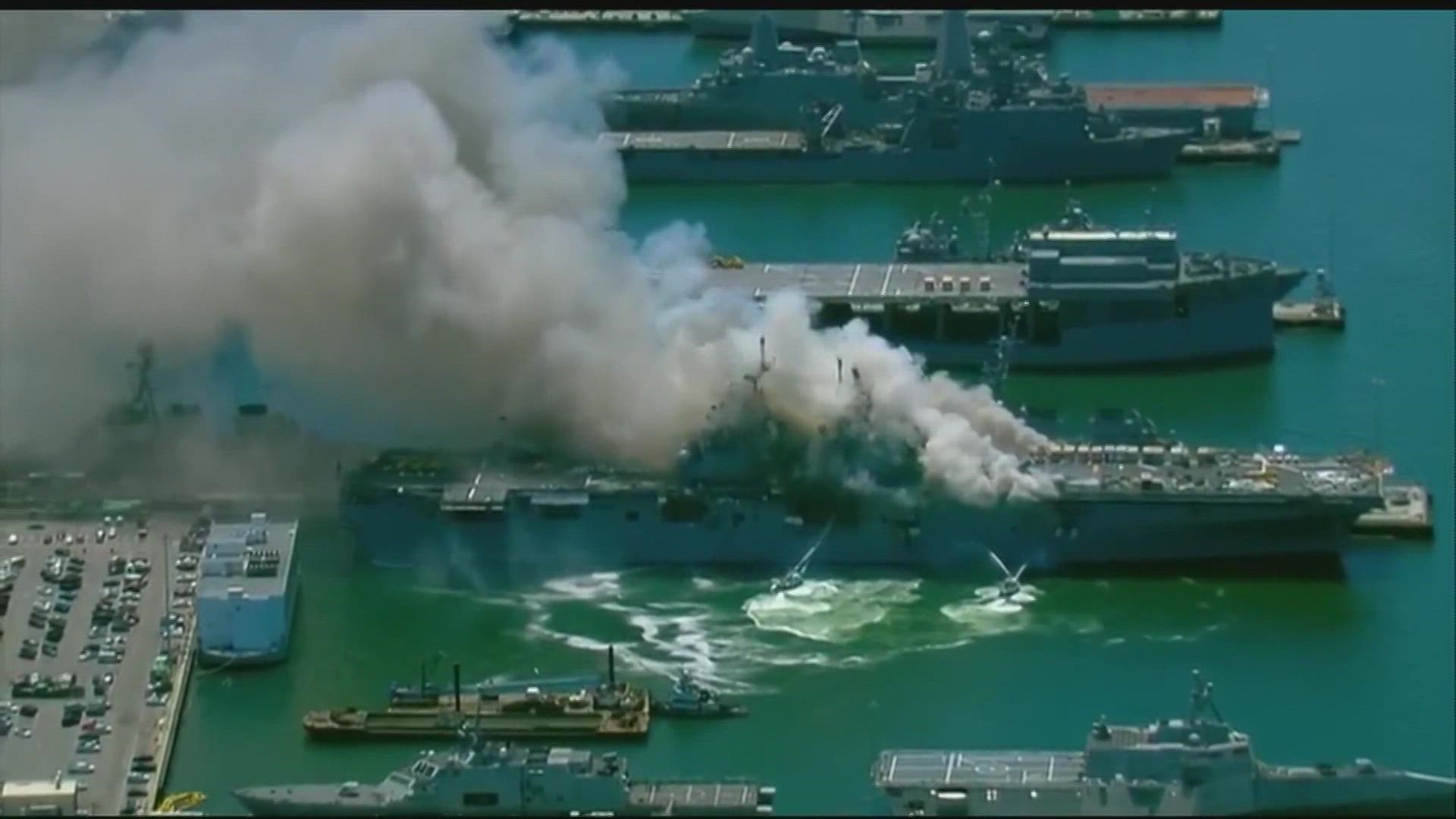SAN DIEGO — On September 19, the U.S. Navy will move full-steam ahead in its effort to hold the sailor who they say set a fire on the amphibious assault ship Bonhomme Richard responsible.
On that day, the trial for Navy Seaman Ryan Sawyer Mays begins.
The Navy says Mays sparked the fire inside the warship's Lower Vehicle Deck on July 12, 2020. The fire burned for nearly five days, destroying the warship. The smoke and ash blanketed San Diego Bay and large portions of the city.
The Navy later scrapped the Bonhomme Richard at a cost of $1.2 billion.
But Mays' attorneys and others say the Navy's battle to paint Mays as a disgruntled sailor who set fire to the ship after failing to become a Navy SEAL is a smokescreen aimed at covering the Navy's lack of preparedness and failure to fight even the smallest blaze onboard the Bonhomme Richard.
Instead, they say the Navy has no physical evidence that Mays had anything to do with the fire and instead is relying on a single eyewitness who said he saw what appeared to be Mays in the "Lower V" before the fire started.
At the same time, one maritime expert blames the Navy and what he calls an "utter breakdown," for taking nearly two hours to get water on the fire.


Smoke Inside The Lower V
At around 8 am on Sunday, July 20, 2020, a sailor walking toward the vending machines saw what looked like "fog" in the Lower V. Not smelling any smoke, the sailor continued on with her duty.
More than 10 minutes later two sailors noticed smoke rising from the Lower V. The sailors reported the smoke to the Officer of the Deck, however, the officer did not sound the main alarm.
According to the Navy's investigation into the fire, crew onboard the warship notified the Duty Fire Marshall at 8:15 am that morning, more than 15 minutes after smoke was first spotted. Shortly after the Officer on Duty finally sounded the main alarms.
As for the reason for the delay in making the announcement, the Officer on Duty told investigators that "he was taught at boot camp to put 'eyes on' a fire before calling it away."
More than 24 minutes after the first sighting of smoke, officers on board the Bonhomme Richard sent a text message to Commanding Officer Capt. Gregory Thoroman to inform him there was a fire.
Meanwhile, the fire continued to burn. It did so with most of its firefighting tools unusable and dismantled.
In particular, the ship's commanding officers failed to restore the warship's most important firefighting tool, the Aqueous Film Forming Foam (AFFF).
"Three months before the fire, Bonhomme Richard was required by policy to restore shipboard firefighting systems when it loaded more than 900,000 gallons of fuel," reads the Navy's October 2021 investigation. "For the AFFF sprinkling systems, Ship’s Force determined only a limited portion would be brought online."
In fact, the limited foam that could be used was useless after the ship's Executive Officer cut off power because he believed the fire was an electrical fire.
By cutting off shore power, the ship was forced to rely only on external water sources and on external firefighters.
At 8:30 am, a half-hour after crew first spotted smoke inside the Lower V, federal firefighters arrived at the pier.
Without any fire stations available and no fire-main on the pier, fire crews were forced to go elsewhere and connect hundreds of feet of hose to make it long enough to reach inside the ship.
Yet, federal firefighters were unsure where the fire was located. When firefighters did find out the location they were not told the quickest way to get to it.
Because of the confusion, a thick blanket of black smoke began to billow from the ship and at 9:15 am, the Commanding Deck Officer ordered all sailors to evacuate.
Ten minutes later a damage control assistant boarded the ship to located the fire. The ship was inundated with smoke. The assistant later told investigators that "he did not consider activating the foam sprinkler system."
Meanwhile, a crew from the San Diego Fire Department tried to enter the Lower V but confusion between federal firefighters and city fire crews boiled over.
"The confusion of the two firefighting teams caused [federal firefighters] to pause, establish accountability, and direct the San Diego Fire Department team to depart the Hangar," reads the command report.
The report says they did not receive any direction about where the fire was and the quickest way to it.
By the time they did make it down to the fire, temperatures had reached an estimated 500 degrees.
Finally, at 9:51 am, nearly two hours after smoke was reported inside the Lower V, San Diego Firefighters began putting water on the fire.
Reads the report, "This was the first time any firefighting agent was employed against active fire."
As conditions worsened inside the warship, San Diego firefighters reported "that they had lost the space" and crews were forced to evacuate.


By 11:24 am sailors and firefighters trained unmanned fire hoses directly into the ship.


The fire inside the massive warship burned for the next four days, draping San Diego's skyline with thick black smoke.
The Investigation
Sal Mercugliano is a professor of Maritime History at Campbell University in North Carolina.
Mercugliano, who hosts the Youtube channel, What is going on With Shipping, says the Bonhomme Richard fire was not exceptional. What was exceptional, says Mercugliano, is the fact the Navy wasn't prepared to fight even the smallest fire.
"Ships have fires on board, it happens frequently, but the fact that that fire got out of control, and then could not be extinguished for nearly five days was just an amazing feat. You got to go back to the sinking of the Normandy in New York Harbor to find something similar," said Mercugliano.
"The saddest part of the story is that this was a fire that most of us would never have heard about," added Mercugliano. "If they had been able to get their teams together, don the gear, lay that hose into the lower V, or even flooded it with the foam. But again, nobody even tried to do it. This fire could have been knocked out in its early stage. I don't think there's any doubt about that."
Mercugliano says the proof of that is in the Navy's own Command Report.
The report stated that while under 88 percent of the Bonhomme Richard's fire systems were down that day, 13 percent were operable.
"They have to know which ones are offline, which ones are online, and make plans to overcome that. But no one even hits the switches.
Added Mercugliano, "The fact that the response was so slow, and they were not able to get water on the fire for such a long period of time really led to the loss of the vessel more than the arson itself."
The Arson Allegations
Attorney Gary Barthel specializes in military law. Barthel represented Seaman Mays until after the preliminary hearings and is still involved with Mays' defense, however, only to help the Navy's public defender.
Barthel says the Navy's lack of evidence and willingness to proceed full steam ahead indicates it is trying to divert attention away from its internal failures and shift the blame on the sailor.
"From the get-go, he always denied it," said Bartel. "His defense is I never did it. He was interrogated for more than eight hours by ATF and NCIS and denied having anything to do with the fire on the ship."
In fact, says Barthel, the Navy is depending on an eyewitness who says he saw what he believed was Mays coming from the Lower V before the fire began. Barthel says the eyewitness did not identify Mays at first but did so after being questioned by investigators.
"The eyewitness said, I saw somebody going down to the Lower V. But I didn't get a good look at them. I'm not sure who it was."
Continued Barthel, "Now, you got to remember this is during COVID. And so the sailors on the ship would wear a baseball cap. They had a mask on. They had coveralls on. And again, he didn't make this claim immediately after the fire."
In addition, Barthel says ATF investigators found no evidence that an accelerant was used to start the fire. And, no fingerprints or DNA from Mays was ever found in the Lower V.
Barthel tells CBS 8 that the Navy also had questions about whether or not Mays was the one to start the fire.
The Other Suspect
Barthel says the Navy interviewed another potential suspect during its investigation.
While Mays was in the brig, Barthel says investigators discovered handwriting left in a restroom on the pier as well as on the ship's bulkhead.
"The handwriting basically said something like, I did it," says Barthel. "The Navy even had handwriting analysis done. And the handwriting analysis came back to this other individual that they were looking at, not Mays. The problem is this other individual was discharged from the Navy. And the Navy lost jurisdiction."
The Navy was convinced enough that investigators released Mays from the brig and had him return to his duties.
But after the other unnamed sailor was discharged, Barthel says the focus returned to Mays. Barthel says further evidence that Navy Command just wants a scapegoat.
"My theory is that the command is going after Mays because blaming somebody for intentionally starting this fire diverts attention away from any kind of negligent cause for the fire. And if there's a negligent cause to the fire, then that's going to reflect poorly on the Navy."
The Navy's Response
CBS 8 reached out to the Navy for comment about the fire and its prosecution of Mays. In a statement, Commander Sean Robertson, spokesperson for the U.S. 3rd Fleet told CBS 8, "After careful review of the preliminary hearing report, Vice Adm. Steve Koehler, commander, U.S 3rd Fleet referred charges against Seaman Recruit Ryan Sawyer Mays to a general court-martial. Charges were brought in response to evidence found during the criminal investigation into the fire that started on the former USS Bonhomme Richard (LHD 6) on July 12, 2020.
When asked for additional details about the Navy's case, Robertson said, "It would be inappropriate to comment on ongoing litigation. Everyone is entitled to a fair trial and the Navy is committed to upholding that principle. A person is presumed innocent until proven guilty in a court of law."
WATCH RELATED: Navy punishes two dozens officers, sailors in USS Bonhomme Richard fire
WATCH RELATED: Defense: USS Bonhomme Richard fire could have been accidental

